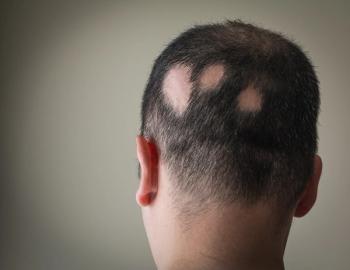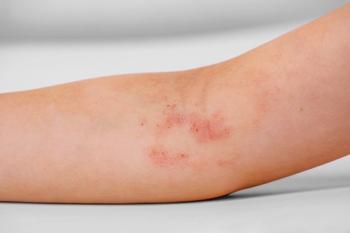
- Consultant for Pediatricians Vol 8 No 12
- Volume 8
- Issue 12
Itchy, Acne-Like Rash on a Boy’s Face and Upper Arms
An 11-year-old boy with 4-month history of acnelike rash on his face and both upper arms. Rash is associated with redness and itching. Application of adapalene gel resulted in no change.
HISTORY
An 11-year-old boy with 4-month history of acnelike rash on his face and both upper arms. Rash is associated with redness and itching. Application of adapalene gel resulted in no change.
Patient has history of chronic otitis media. He is otherwise healthy.
PHYSICAL EXAMINATION
Erythema and follicular papules noted in maxillary and preauricular areas bilaterally. Erythema and hyperkeratotic follicular papules noted on both upper arms. Both external ears and pinnae are erythematous.
No evidence of alopecia, eyebrow thinning, follicular atrophy, or scarring.
WHAT'S YOUR DIAGNOSIS?
ANSWER: KERATOSIS PILARIS RUBRA
Keratosis pilaris is a benign keratinization disorder characterized by keratinous plugs in follicular orifices. Its prevalence has been reported to be as high as 44%.1 The rash has 2 patterns of presentation:
• Lesions begin in childhood (before age 2 years), affect the face and arms, peak in early adolescence, and resolve in later years.
• Lesions begin in adolescence, affect the lateral aspects of the arms and legs, and spontaneously involute in adulthood (mid-20s).2
Keratosis pilaris rubra-as seen in this patient-is characterized by follicular papules on the face and cheeks, prominent erythema, and hyperkeratotic papules on the upper arms. The thighs and buttocks may also be affected. This variant is also called keratosis pilaris rubra faceii and is thought to be underrecognized.3
ETIOLOGY AND ASSOCIATIONS
The cause remains unknown. An autosomal dominant mode of inheritance with variable penetrance has been reported.4 Other modes of inheritance have been postulated.
Keratosis pilaris has been associated with atopy,1 diabetes, and obesity.5 It may be associated with Cushing disease, hypothyroidism, vitamin A intoxication, vitamin C deficiency, monilethrix, Hodgkin disease, monosomy 18p, and cardio-facio-cutaneous syndrome.6
HISTOPATHOLOGY
Histopathological examination reveals a nonspecific pattern of distended follicular orifices with keratin plugs and mild inflammatory changes in the dermis.2
CLINICAL FEATURES AND DIFFERENTIATION FROM VARIANTS
Keratosis pilaris manifests as tiny, keratotic, follicular papules with variable erythema.2 The rash appears like “nutmeg grater” skin or chicken flesh and feels rough. It may be pruritic. The lesions have a predilection for the lateral aspects of the upper arms (92% of patients), thighs (59%), and buttocks (30%); they develop less frequently on the cheeks.7
There are several recognized variants of keratosis pilaris; the features of some of these overlap to a degree. The variants whose features are most similar to those of keratosis pilaris rubra are:
• Erythromelanosis follicularis faciei et colli. This rash develops in the second decade of life, most commonly in males, and is characterized by symmetrical follicular papules with perifollicular erythema on the cheeks, forehead, and neck.2 It can be differentiated from keratosis pilaris rubra by the presence of hyperpigmentation, lack of involvement of the torso, and late onset of presentation.3
• Keratosis pilaris atrophicans. The most prominent features of this rash are follicular atrophy and scarring. There are 3 types:
-Ulerythema ophryogenes (also called keratosis pilaris atrophicans faciei) initially affects the lateral third of the eyebrows and later progresses to the cheeks and forehead. It is mostly associated with keratosis pilaris of the arms and legs.
-Atrophoderma vermiculatum is characterized by follicular plugs and pitlike depressions up to 1.5 mm in diameter, predominantly on the cheeks. These pits coalesce, resulting in a “worm-eaten” or “honeycombed” appearance.
-Keratosis follicularis spinulosa decalvans begins in infancy and is characterized by follicular spines on hair bearing areas, especially the scalp, eyebrows, and eyelashes. It results in scarring alopecia of the affected areas in puberty.2
DIFFERENTIAL DIAGNOSIS
The differential diagnosis of keratosis pilaris includes atopic dermatitis, acne, rosacea, and pityriasis rubra pilaris. Clues to the diagnosis of keratosis pilaris rubra in the patient described include the chronic persistent course, the pattern of follicular papules and perifollicular erythema, and the resistance to treatment. The involvement of the arms and other parts of the body in addition to the face confirms the diagnosis of keratosis pilaris rubra.
TREATMENT AND OUTCOME
Keratolytic agents such as salicylic acid preparation, topical retinoids, and tazarotene have been used with some success in patients with keratosis pilaris rubra.8 Topical preparations may aggravate the erythema, thus patients should be informed of this adverse effect.2 In other variants of keratosis pilaris, the response to topical therapy is variable and often unsuccessful.2 Other reported treatments include potassium titanyl phosphate laser therapy, topical corticosteroid therapy, pulsed dye laser therapy, and oral vitamin A.
Salicylic acid 6% ointment was prescribed for this patient. At follow-up a few months later, the erythema had decreased somewhat, but the hyperkeratotic papules remained unchanged.
References:
REFERENCES:1. Mevorah B, Marazzi A, Frenk E. The prevalence of accentuated palmoplantar markings and keratosis pilaris in atopic dermatitis, autosomal dominant ichthyosis vulgaris and control dermatological patients. Br J Dermatol. 1985;112:679-685.
2. Rogers M. Keratosis pilaris and other inflammatory follicular keratotic syndromes. In: Wolff K, Goldsmith LA, Katz SI, et al, eds. Fitzpatrick's Dermatology in General Medicine. 7th ed. New York: McGraw-Hill; 2008:749-753.
3. Marqueling AL, Gilliam AE, Prendiville J, et al. Keratosis pilaris rubra: a common but underrecognized condition. Arch Dermatol. 2006;142:1611-1616.
4. Callaway SR, Lesher JL Jr. Keratosis pilaris atrophicans: case series and review. Pediatr Dermatol. 2004;21:14-17.
5. Yosipovitch G, Mevorah B, Mashiach J, et al. High body mass index, dry scaly leg skin and atopic conditions are highly associated with keratosis pilaris. Dermatology. 2000;201:34-36.
6. Leung AKC, Kao CP. What's your diagnosis? Keratosis pilaris. Consultant for Pediatricians. 2004;3:188, 191.
7. Judge MR, McLean WH, Munro CS. Disorders of keratinization. In: Burns DA, Breathnach SM, Cox NH, Griffiths CE, eds. Rook's Textbook of Dermatology. 7th ed. Oxford, England: Blackwell Publishing; 2004:34.60-34.62.
8. Gerbig AW. Treating keratosis pilaris. J Am Acad Dermatol. 2002;47:457.
Articles in this issue
almost 16 years ago
Will We Ever Get Back to Bedford Falls?almost 16 years ago
When to Consider Surgery for an Obese Teenalmost 16 years ago
Photo Essay: An Array of Hyperpigmented Lesionsalmost 16 years ago
Hot Tub Folliculitis in a 5-Year-Old Girlalmost 16 years ago
Heiner Syndromealmost 16 years ago
Welcome, Dr Prashant Mahajanalmost 16 years ago
Status Epilepticus: Evaluation and Managementalmost 16 years ago
An itchy eruption puts a damper on a girl’s Hawaiian vacation.Newsletter
Access practical, evidence-based guidance to support better care for our youngest patients. Join our email list for the latest clinical updates.














